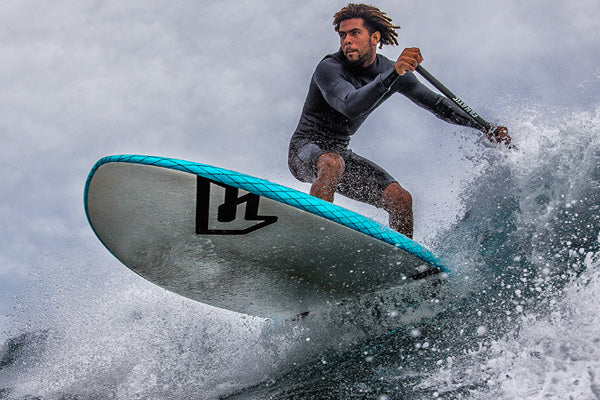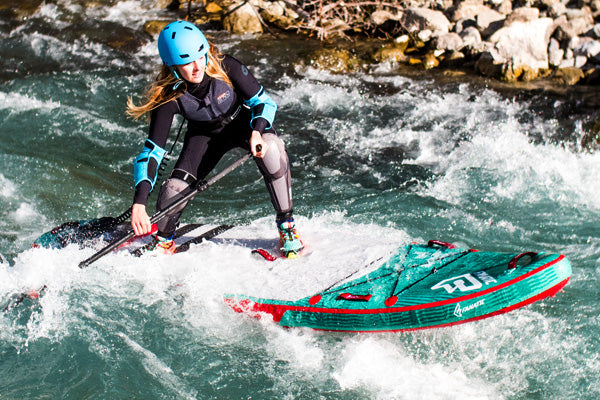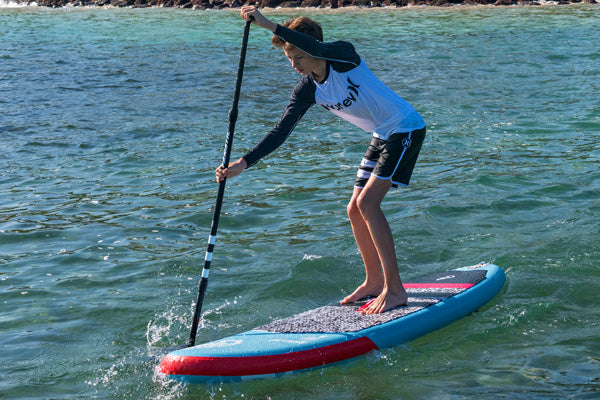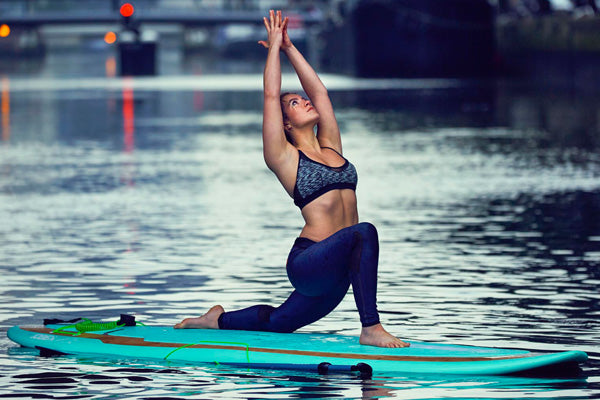SUP BOARD GUIDE
STARTING THE SPORT WITHOUT ANY KNOWLEDGE?
Deciding early on the specific type of paddLEBOARDING you’d prefer to do, WIll immediately MAKE it easier to reduce the OPTIONS AVAILABLE.
Allround:
Activities include short runs, waves and occasional flat water distances.
10'6" is a great all-round size.
Touring:
12'6" is a great board size for touring.
SURFING:
SUP Surf boards generally have less volume but designed for quick turns on the waves.
RACING:
These boards are normally narrower in width and over 12'0".
RAPIDS / WHITEWATER:
These characteristics allow you to navigate around obstacles and challenging environment.
KIDS:
Boards between 8' and 10' provide a good sized boards with a thickness of no more than 4".
YOGA / FITNESS:
Allowing you to naturally listen to your body and respond to the movements of the board.
What volume should I be considering?
 Where the board sits in the water with you and your stuff on it is important.
Where the board sits in the water with you and your stuff on it is important.
If the board sits too low in the water it will feel uneasy, manoeuvrability will be lost and it’ll be slow and hard work as you have to displace more water.
Volume is shown in litres and you’ll need at least double of the number of kilos you weigh with all your stuff and clothing.
Example: If you weigh 85kg you’ll need a minimum of 170 litres volume in the board.
What thickness should I be choosing?
 Starting out we’re after buoyancy both in the middle of the board and at the edges to give us stability.
Starting out we’re after buoyancy both in the middle of the board and at the edges to give us stability.
Example: Boards between 4”-6” thick across the range of SUP boards are highly recommended.
Be aware that volume and thickness data becomes more complex when shape refinements are built into a design.
A board with the right volume might be unsuitable on flat water if the edges or tail are thinner for instance. Thickness and Width variations and shaping on a board can alter its ride significantly.
Thicker Boards are generally more rigid and rigidity is important so for a thin inflatable board to remain rigid its pressure has to be higher.
Lighter paddlers may not have a problem but too heavier a paddler will bend a thin board which isn’t good.
Just a word of warning on the above the build on a board could be incapable of inflation pressures required to ‘modify’ stiffness.
The higher the Max pressure specification the board has the more rigid and better build quality the board is likely to have.
It’s worth mentioning also that the very thick 6” all-round boards may seem like an obvious option but they do have drawbacks such as height above the water, this raises the centre of gravity and thus decreases stability over say a 4” or 5”. It becomes harder to get back onto after a fall and is affected more by wind steer. Pumping it up will take longer of course and the extra thickness makes it more difficult to carry.
WHO SHOULD I CHOOSE THE WIDTH?
 Scale your board width on your weight, height, skill and aspirations.
Scale your board width on your weight, height, skill and aspirations.
The general rule is the wider the board is the more stable it is but boards can have comparable widths but in a different places. If you are just getting into SUP and your choice is an all-rounder the board shape is going to be reasonable parallel sided with the widest part from the middle of the board and forward.
Board widths may vary from around 28”-36”/
The narrower the board is the quicker it will glide as it has to displace less water but it will be sacrificing balance.
Bigger, heavier or taller paddlers will find it easier to balance using wider boards, say 34” whereas shorter lighter weight paddlers will be happy enough on much narrower boards (30”).
Even an experienced paddler wanting to do river rapids or ocean surf may want to max out on width for stability but reduce the length and select a shape for manoeuvrability.
 There are lots of variants with Surf SUPs as short as 4’0" and Touring and Race SUPs 14’0 "or more.
There are lots of variants with Surf SUPs as short as 4’0" and Touring and Race SUPs 14’0 "or more.
For all users the 10’6”sits right in the middle but remember if you’re bigger taller less experienced you’ll need more buoyancy so longer or wider is a good idea. Consider storage too, if you opt for a solid board then wherever it’s stored has to accommodate it whereas an inflatable SUP deflated doesn’t pose the same storage problem.
For touring and certainly for racing boards it will be easier on the body if the board is narrower as less water needs to be displaced and speed and glide is improved significantly.
At the same time we still need buoyancy and straight line speed is preferred over manoeuvrability so these boards get longer in length typically around 12’6 and longer”.
Surfers require manoeuvrability so the boards become shapelier often thinner with rocker, wider in middle to front and narrower in the tail where the rider can be equally buoyant by using speed.
The shorter lengths and additional fin configuration allow quick directional changes happen so the wave can be mastered.
What Shape Do I Need?
 The majority of SUP boards are rounded with a rocker curve added to the nose making it rise up and out of the water giving the board properties for cruising lakes, rivers or surf.
The majority of SUP boards are rounded with a rocker curve added to the nose making it rise up and out of the water giving the board properties for cruising lakes, rivers or surf.
They can be pointed (pinched) particularly in touring and racing boards where the board length is increased to reduce width and retain buoyancy plus offering extra speed and glide. The nose design can often be partially immersed offering better water displacement and flow around the SUP.
Generally non round, narrower, sharper tails release water quicker improving manoeuvrability. Round tail stability can be retained by squarer cut off tails.
How Important are the Rails?
Rails and their shape are important as they manage grip, drag and the release of water.
The longer the waterline (rail in the water) usually the more speed a paddleboard will have.
The widely used rounded rails called soft rails gives you grip but reduces speed, its volume offers buoyancy. We often see them on All-round SUPs and some Surf SUPs but wouldn’t be ideal on a Race SUP.
If you run your hand down a SUP rail and it feels flatter at the bottom this is known as a harder or sharper rail. The design is good for Race SUPs as the sharper edge allows the water to release quickly giving you speed and if the rail is designed thinner this gives the Surf SUPs more performance and bite on the wave.
There’s a myriad of shapes in between the basics above but for starters you’re going to be investing in the rounded soft rail.
Are there different styles of decks?
SUP deck pads are designed primarily to offer grip, comfort and support.
Domed decks have the benefit of volume but also thinner rail shapes and probably best suited for performance and surf SUPs. On flat water more comfort is attained on a flatter decked SUP.
Flatter Decks on SUPs allows volume to be moved from the middle of the SUP to the edges offering greater stability. The SUP being flatter is thinner offering greater feedback and more comfortable to paddle on flat water or racing. Performance Surf SUP’s may however prefer the domed deck due to rail design.
Modern Race SUPs can have concave decks to combat instability created by being narrow. Standing within the concave area gives the paddler a lower Centre of Gravity aiding stability. Volume is moved to the nose, rail and tail.
DECK FEATURES TO CONSIDER:
- SUP Deck Bags are always useful for stashing away safety, repair kits, food and sundries away and dry.
- SUP Bungee Deck Tie down for stowing carried items.
- Handles on board the middle, side front and back.
- D-rings for attaching all sorts.
- Camera fitting points.
- Leash and fixing point.
- Structural Battens for stiffening.
 DROPSTITCH TECHNOLOGY:
DROPSTITCH TECHNOLOGY:
Internal threads are positioned between a dropstitch layer which when filled with air will allow the board to only expand to a certain point before they pull tight and form a rigid SUP shape.
Dropstitch fabric on its own isn't airtight, so then a liquid PVC layer covers the dropstsitch to create an airtight seal. This is the single skin. Less material makes for a very lightweight SUP.
 STRINGER TECHNOLOGY:
STRINGER TECHNOLOGY:
Utilising drop stitch material, stringer technology provides an outstanding durability / weight / price / performance ratio with its centre stinger keeping the shape strong and stiff, while reducing weight and price at the same time.
A thin 'stringer' runs down the centre of the board from nose to tail to provide increased rigidity. The stringer is glued down the centre of the board.
 DOUBLE LAYER TECHNOLOGY:
DOUBLE LAYER TECHNOLOGY:
Featuring a second PVC layer, that is welded directly to the core layers and around the drop stitch material, an additional layer is laminated onto the board reducing any bumps or bubbles from the construction process.
This not only make the SUP look great but also has a 20–25 % reduction in weight, and around 25-30 % increase in stiffness.
SUP BOARD VOLUME GUIDE
| Volume (Litres) | ||||
| Stones / Kg | 120 | 130 | 140 | 150 |
| ≤ 9 / 57kg | ||||
| 10 / 63kg | ||||
| 11 / 69kg | ||||
| 12 / 76kg | ||||
| *For use as a guide only | ||||
| Volume (Litres) | ||||
| Stones / Kg | 170 | 180 | 190 | 200 |
| 13 / 80kg | ||||
| 14 / 90kg | ||||
| 15 / 95kg | ||||
| 16 / 100kg | ||||
| *For use as a guide only | ||||
SUP BOARD TECHNIQUE
LEARN THE BASICS OF SUP OR SIMPLY BRUSH UP ON YOUR PADDLING TECHNIQUES, THESE VIDEOS WILL HELP YOU IMPROVE YOUR SKILLS.
SUP KIDS:
Getting kids into SUP can be a great fun way to get kids outdoors and on the water for the first time. When done right it’s not only great fun but also a great way to increase their water confidence as well as balance and coordination.
STANDING UP:
When it comes to standing up for the first time on a SUP having a few good tips as well the right kit can make all the difference between getting up and staying up, and not getting to your feet at all!
PADDLING STRAIGHT:
Standing up for the first time on a SUP you've hopefully got to your feet and mastered the basics of paddling.
But chances are you're finding it difficult paddling straight!
STEP BACK / PIVOT TURNS:
One of the more advanced stand up paddle board techniques, the step back turn is a great way of turning around quickly. Also known as a pivot turn or buoy turn, the step back turn is a sharp way of turning round and is great in every water environment.
CATCHING A WAVE:
When it comes to catching your first waves on a SUP there are a few things that can make the whole experience way easier and more fun!
PADDLING INTO THE WIND:
Paddling into the wind is never much fun, but chances are you'll be doing a bit of upwind paddling at some point during your session, so it's worth perfecting your upwind paddling technique.
PADDLE BRACE FOR STABILITY:
The paddle brace is a paddle board technique that is formed to give extra stability. It is used when moving around the board, in choppy conditions or in the surf.
COMMON MISTAKES:
Paddleboarding isn't complicated, just grab a SUP and a paddle and head for the water. But there are a few common paddle mistakes made by beginners which can make paddling unstable and inefficient.






